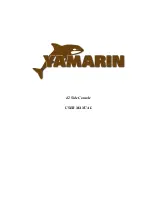
Electrical System
4-13
Section 4
OS 385
sound and there are no loose or corroded
terminals. Clean any corroded terminals
thoroughly with sandpaper, or replace them.
Tighten securely and spray with a metal and
electrical protector. Inspect all engine wiring.
Check the electrolyte level in the batteries
regularly and add distilled water as neces-
sary. If the batteries are frequently charged
by a battery charger, check the electrolyte
level more often. The correct fluid level in the
cells is approximately ¼ to ½ inch above the
plates. If fluid is needed, fill to the proper
level with distilled water ONLY. DO NOT
overfill. Some batteries are sealed and can-
not be filled.
Keep the tops of any battery clean and dry.
Dirt and water can conduct electricity from
one post to the other and can cause battery
discharge or cause errant engine warnings.
Keep the battery posts free of corrosion. DO
NOT use wing nuts to attach battery cables.
Remove the cables and clean the posts and
cable clamps with a battery post cleaner or
sandpaper as required. Coating the battery
posts and cable clamps with petroleum jelly
or silicone grease will help protect and
reduce corrosion. Battery cables, both posi-
tive and ground must be replaced when they
show signs of corrosion or fraying. Deterio-
rated cables cause a considerable voltage
loss when high currents are drawn, as for
starting the engine.
AC Electrical System Maintenance
Inspect all wiring insulation for nicks, chaf-
ing, brittleness, improper support, etc. peri-
odically. Also, inspect portable appliance
cords and plugs.
Examine the shore power cord for cracks in
the insulation and corrosion in electrical con-
nectors. Spraying receptacles and electrical
connections with an electrical contact
cleaner or a metal and electrical protector
will help reduce corrosion and improve elec-
trical continuity.
GENERAL PRECAUTIONS
•
DO NOT work on an energized system;
make sure all power sources are off.
•
DO NOT allow unqualified personnel to
perform electrical maintenance; only a
qualified marine electrician should work
on the electrical system.
•
DO NOT work in a wet area.
•
Use caution when connecting wires to
avoid reversing polarity.
•
DO NOT alter wires, connectors or use
inferior parts; use OEM replacement
parts only.
Corrosion on the electrical connectors can
cause poor connections, shorts and ground
faults, and/or poor ground connections.
Check at least annually and clean as
required. DO NOT allow corrosion to build
on connections.
Inspect all terminals and make sure they are
tight.
!
DANGER
FIRE OR EXPLOSION HAZARD
Explosion or fire from hydrogen gases
produced by lead acid batteries will
cause death or serious injury. DO NOT
smoke or bring a flame near battery
storage area. If ignited by a spark or
flame, gas may explode violently,
causing spraying of battery acid or
fragmentation of the battery.
!
DANGER
ELECTROCUTION, FIRE OR
EXPLOSION HAZARD
Contact with live wires or working on
an energized electrical system will
cause electrocution. It can also cause
sparks, resulting in fire and/or explo-
sion. Both cases will result in death or
serious injury. DO NOT work on an
energized system or allow unqualified
personnel to work on the system.
Summary of Contents for OS 345
Page 2: ......
Page 4: ...Operator Notes OS 375...
Page 16: ...12 Operator Notes OS 385...
Page 32: ...3 6 Operator Notes OS 385...
Page 34: ...4 2 Section 4 Electrical System OS 385 Main Distribution Panel MDP...
Page 54: ...5 8 Operator Notes OS 385...
Page 56: ...6 2 Operator Notes OS 385...
Page 98: ...12 6 Operator Notes OS 385...
Page 104: ...A 6 Operator Notes OS 385...
Page 106: ...B 2 Appendix B Maintenance Log OS 385 Date Hours Dealer Service Repairs Maintenance Log...
Page 107: ...Maintenance Log B 3 Appendix B OS 385 Date Hours Dealer Service Repairs...
Page 108: ...B 4 Appendix B Maintenance Log OS 385 Date Hours Dealer Service Repairs...
Page 109: ...Boating Accident Report C 1 Appendix C OS 385 Boating Accident Report...
Page 110: ...C 2 Appendix C Boating Accident Report OS 385...
Page 111: ...Float Plan D 1 Appendix D OS 385 Float Plan...
Page 112: ...D 2 Operator Notes OS 385...
Page 116: ...E 4 Operator Notes OS 385...
Page 117: ...Schematics F 1 Appendix F OS 385 Schematics...
Page 118: ...F 2 Appendix F Schematics OS 385...
Page 119: ...Schematics F 3 Appendix F OS 385...
Page 120: ...F 4 Appendix F Schematics OS 385...
Page 121: ...Schematics F 5 Appendix F OS 385...
Page 122: ...F 6 Appendix F Schematics OS 385...
Page 123: ...Schematics F 7 Appendix F OS 385...
Page 124: ...F 8 Appendix F Schematics OS 385...
Page 125: ...Schematics F 9 Appendix F OS 385...
Page 126: ...F 10 Appendix F Schematics OS 385...
Page 127: ...Schematics F 11 Appendix F OS 385...
Page 128: ...F 12 Appendix F Schematics OS 385...
Page 129: ...Schematics F 13 Appendix F OS 385...
Page 130: ...F 14 Appendix F Schematics OS 385...
Page 131: ...Schematics F 15 Appendix F OS 385...
Page 132: ...F 16 Appendix F Schematics OS 385...
Page 133: ...Schematics F 17 Appendix F OS 385...
Page 134: ...F 18 Appendix F Schematics OS 385...
Page 135: ...Schematics F 19 Appendix F OS 385...
Page 136: ...F 20 Appendix F Schematics OS 385...
Page 137: ...Schematics F 21 Appendix F OS 385...
Page 138: ...F 22 Appendix F Schematics OS 385...
Page 139: ...Schematics F 23 Appendix F OS 385...
Page 140: ...F 24 Appendix F Schematics OS 385...
Page 141: ...Schematics F 25 Appendix F OS 385...
Page 142: ...F 26 Operator Notes OS 385...
Page 143: ......
Page 144: ......
















































